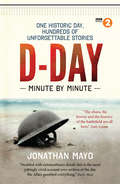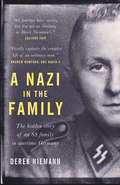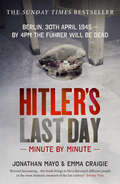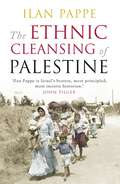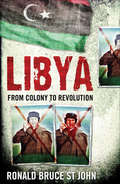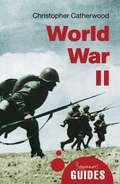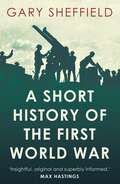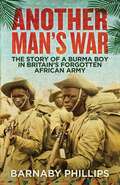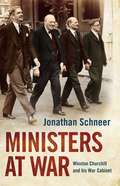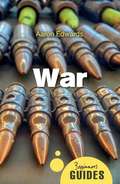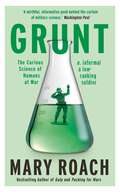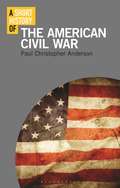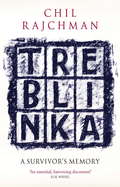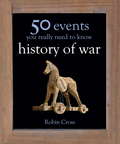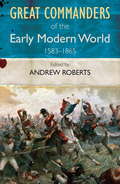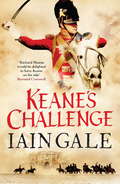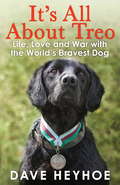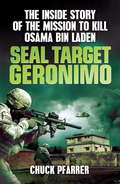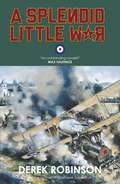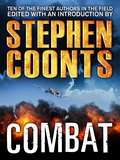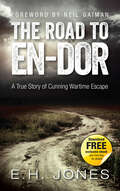- Table View
- List View
D-Day Minute By Minute: One historic day, hundreds of unforgettable stories (Minute By Minute)
by Jonathan MayoThe invasion has begun. In this gripping book, Jonathan Mayo gives a blow by blow account of the events of D-Day, revealing what happened to the people swept up in this crucial moment in history. From soldiers, French villagers and journalists, to schoolchildren and nurses, thousands were placed in extraordinary situations when the Allies landed in Normandy. This is their story.
A Nazi in the Family: The hidden story of an SS family in wartime Germany
by Derek NiemannWARTIME BERLIN: The Niemann family - Karl, Minna and their four children - live in a quiet, suburban enclave. Every day Karl commutes to work, a business manager travelling around inspecting his “factories”. In the evenings he returns home to life as a normal family man.Three years ago Derek Niemann, born and raised in Scotland, made the chilling discovery that his grandfather Karl had been an officer in the SS - and that his “business” used thousands of slave labourers in concentration camps, such as Auschwitz, Dachau, Buchenwald and Sachsenhausen. Derek had known little about the German side of his family, but now a lifetime of unsettling hints and clues began to fall into place.With the help of surviving relatives and hundreds of previously unknown family photographs, Derek uncovers the true story of what Karl did. A Nazi in the Family is an illuminating portrayal of how ordinary people can fall into the service of a monstrous regime.
Hitler's Last Day: The Hidden Story Of An Ss Family In Wartime Germany (Minute By Minute Ser.)
by Jonathan Mayo Emma CraigieOn 30th April 1945 Germany is in chaos...Russian troops have reached Berlin. All over the country, people are on the move - concentration camp survivors, Allied PoWs, escaping Nazis - and the civilian population is fast running out of food. The man who orchestrated this nightmare is in his bunker beneath the capital, saying his farewells.This is the gripping story of Hitler's final hours, as seen through the eyes of those who were with him in the bunker; those fighting in the streets of Germany; and those pacing the corridors of power in Washington, London and Moscow.30th April 1945 was a day that millions had dreamed of, and millions had died for.
The Ethnic Cleansing of Palestine
by Ilan PappeThe book that is providing a storm of controversy, from &‘Israel&’s bravest historian&’ (John Pilger)Renowned Israeli historian, Ilan Pappe's groundbreaking work on the formation of the State of Israel. 'Along with the late Edward Said, Ilan Pappe is the most eloquent writer of Palestinian history.' NEW STATESMAN Between 1947 and 1949, over 400 Palestinian villages were deliberately destroyed, civilians were massacred and around a million men, women, and children were expelled from their homes at gunpoint. Denied for almost six decades, had it happened today it could only have been called 'ethnic cleansing'. Decisively debunking the myth that the Palestinian population left of their own accord in the course of this war, Ilan Pappe offers impressive archival evidence to demonstrate that, from its very inception, a central plank in Israel&’s founding ideology was the forcible removal of the indigenous population. Indispensable for anyone interested in the current crisis in the Middle East. *** 'Ilan Pappe is Israel's bravest, most principled, most incisive historian.' JOHN PILGER 'Pappe has opened up an important new line of inquiry into the vast and fateful subject of the Palestinian refugees. His book is rewarding in other ways. It has at times an elegiac, even sentimental, character, recalling the lost, obliterated life of the Palestinian Arabs and imagining or regretting what Pappe believes could have been a better land of Palestine.' TIMES LITERARY SUPPLEMENT 'A major intervention in an argument that will, and must, continue. There's no hope of lasting Middle East peace while the ghosts of 1948 still walk.' INDEPENDENT
Libya
by Ronald Bruce St. JohnCombining a historian's balance with an analyst's insight to skilfully navigate Libya's eventful past and present, Ronald Bruce St John updates his authoritative history of this turbulent North African state to include an in-depth examination of the 2011 rebellion that finally put an end to over 40 years of authoritarian rule by Qadaffi. From early Greek settlements to the infamous Lockerbie bombing, and from the colonel's astonishing return to the international stage to the events that led to his ousting, this stands as an essential introduction to this complex land on the cusp of Africa and the Middle East. Ronald Bruce St John is a scholar of Libya, having consulted to ABC's 20/20, the New York Times, Fortune 500 companies, and the U.S. government. Now an analyst for the progressive think tank Institute for Policy Studies, he has also served on the advisory board of The Journal of Libyan Studies and the Atlantic Council's working group on Libya. A former military intelligence officer in the US army, he is the author of Libya and the United States and Qaddafi's World Design, among other books.
World War II: A Beginner's Guide (Beginner's Guides)
by Christopher CatherwoodWith over sixty million casualties, World War II was the bloodiest conflict in history. In this incisive introduction, esteemed academic Christopher Catherwood covers all the key battles and campaigns, while also giving the larger story behind them, putting familiar events into the perspective of the war at large. He explores the huge impact of the preceding Sino-Japanese War on World War II itself; the relative unimportance of the British conflict in Africa; the near moral-equivalence of the Red Army and the Nazis; and the impact of the Hiroshima bombing. Full of text-boxes revealing key details about British intelligence, weaponry, and the social milieu to the conflict, there is no better brief introduction to this landmark event.
A Short History of the First World War (Short Histories Ser.)
by Gary SheffieldSynthesizing the latest scholarship, acclaimed military historian Gary Sheffield cuts to the heart of the conflict that involved every major economic power in the world. With an emphasis on the Western Front, Sheffield explores such key issues as the causes of war; the search for peace and the peace settlements; the political, social, and economic consequences; the impact of "total war" on the war efforts of the belligerents; and the place of the War in the history of warfare. Accessible and incisive, this is the ultimate introduction for anyone wanting a clear understanding of what happened and why.
Another Man's War: The Story Of A Burma Boy In Britain's Forgotten Army
by Barnaby PhillipsIn December 1941 the Japanese invaded Burma. For the British, the longest land campaign of the Second World War had begun. 100,000 African soldiers were taken from Britain’s colonies to fight the Japanese in the Burmese jungles. They performed heroically in one of the most brutal theatres of war, yet their contribution has been largely ignored. Isaac Fadoyebo was one of those 'Burma Boys’. At the age of sixteen he ran away from his Nigerian village to join the British Army. Sent to Burma, he was attacked and left for dead in the jungle by the Japanese. Sheltered by courageous local rice farmers, Isaac spent nine months in hiding before his eventual rescue. He returned to Nigeria a hero, but his story was soon forgotten. Barnaby Phillips travelled to Nigeria and Burma in search of Isaac, the family who saved his life, and the legacy of an Empire. Another Man’s War is Isaac’s story.
Ministers at War: Winston Churchill and his War Cabinet
by Jonathan SchneerBritain's wartime cabinet brought together Conseratives, Labour and independent in a coalition of political titans, including Bevan, Atlee, Beverbrook, Morrison, Eden and Cripps. This is the gripping story of how they governed and won. Under Churchill's leadership they overcame political and personal differences in service of the national interest in a time of great crisis.But behind closed doors there were rivalries and intrigues, as well as unexpected friendships - brought to life here through Jonathan Schneer's original research and vivid writing. With fascinating portraits of the figures involved and sharp analysis of the political ups and downs, Ministers at War is a unique and essential perspective on World War II.
War: A Beginner's Guide (Beginner's Guides)
by Aaron EdwardsWar has been a perennial feature of human history since ancient times, yet it remains a poorly understood phenomenon. It has done much to shape our world, from overthrowing leaders, establishing international governance, and inspiring social change, to destroying cities, dividing nations and breeding animosity.In this book, Dr Aaron Edwards succinctly combines political theories with historical realities. Using eyewitness accounts, war poetry and insightful analysis of a wide range of conflicts, War: A Beginner's Guide introduces the reader to the complexity and human face of war and invites readers to question whether violence is the most effective way to resolve disputes.
Grunt: The Curious Science of Humans at War
by Mary RoachA finalist for the Los Angeles Times Science & Technology Book Prize &‘The most entertaining writer in science&’ – The Times, Books of the Year War. Mention it and most of us think of history, of conflicts on foreign soil, of heroism and compromise, of strategy and weapons. But there&’s a whole other side to the gruesome business of the battlefield. In Grunt, the inimitable Mary Roach explores the science of keeping human beings intact, awake, sane, uninfected and uninfested in the bizarre and extreme circumstances of war. Setting about her task with infectious enthusiasm, she sniffs World War II stink bombs, tests earplugs in a simulated war zone and burns the midnight oil with the crew of a nuclear submarine. Speaking to the scientists and the soldiers, she learns about everything from life-changing medical procedures to innovations as esoteric as firing dead chickens at fighter jets. Engrossing, insightful and laugh-out-loud funny, this is an irresistible ride to the wilder shores of modern military life.
A Short History Of The American Civil War (Short Histories)
by Paul Christopher AndersonThe American Civil War (1861-65) remains a searing event in the collective consciousness of the United States. It was one of the bloodiest conflicts in modern history, claiming the lives of at least 600,000 soldiers and an unknown number of civilians and slaves. The Civil War was also one of the world's first truly industrial conflicts, involving railroads, the telegraph, steamships and mass-manufactured weaponry. The eventual victory of the Union over the Confederacy rang the death-knell for American slavery, and set the USA on the path to becoming a truly world power. <p><p> Paul Christopher Anderson shows how and why the conflict remains the nation's defining moment, arguing that it was above all a struggle for power and political supremacy but was also a struggle for the idea of America. Melding social, cultural and military history, the author explores iconic battles like Shiloh, Chickamauga, Antietam and Gettysburg, as well as the bitterly contesting forces underlying them and the myth-making that came to define them in aftermath. He shows that while both sides began the war in order to preserve - the integrity of the American state in the case of the Union, the integrity of a culture, a value system, and as slave society in the case of the Confederacy - it allowed the American South to define a regional identity that has survived into modern times.
Treblinka: A Survivor's Memory
by Chil RajchmanChil Rajchman, a Polish Jew, was arrested with his younger sister in 1942 and sent to Treblinka, a death camp where more than 750,000 were murdered before it was abandoned by German soldiers. His sister was sent to the gas chambers, but Rajchman escaped execution, working for ten months under incessant threats and beatings as a barber, a clothes-sorter, a corpse-carrier, a puller of teeth from those same bodies. In August 1943, there was an uprising at the camp, and Rajchman was among the handful of men who managed to escape. In 1945, he set down this account, a plain, unembellished and exact record of the raw horror he endured every day. This unique testimony, which has remained in the sole possession of his family ever since, has never before been published in English. For its description of unspeakably cruelty, Treblinka is a memoir that will not be superseded. In addition to Rajchman's account, this volume includes the complete text of Vasily Grossman's 'The Hell of Treblinka', one of the first descriptions of a Nazi extermination camp; a powerful and harrowing piece of journalism written only weeks after the camp was dissolved. Introduction by Samuel Moyn, Professor of History at Columbia University and author of A Holocaust Controversy: The Treblinka Affair in Postwar France.
Treblinka: A Survivor's Memory
by Chil RajchmanChil Rajchman, a Polish Jew, was arrested with his younger sister in 1942 and sent to Treblinka, a death camp where more than 750,000 were murdered before it was abandoned by German soldiers. His sister was sent to the gas chambers, but Rajchman escaped execution, working for ten months under incessant threats and beatings as a barber, a clothes-sorter, a corpse-carrier, a puller of teeth from those same bodies. In August 1943, there was an uprising at the camp, and Rajchman was among the handful of men who managed to escape. In 1945, he set down this account, a plain, unembellished and exact record of the raw horror he endured every day. This unique testimony, which has remained in the sole possession of his family ever since, has never before been published in English. For its description of unspeakably cruelty, Treblinka is a memoir that will not be superseded. In addition to Rajchman's account, this volume includes the complete text of Vasily Grossman's 'The Hell of Treblinka', one of the first descriptions of a Nazi extermination camp; a powerful and harrowing piece of journalism written only weeks after the camp was dissolved. Introduction by Samuel Moyn, Professor of History at Columbia University and author of A Holocaust Controversy: The Treblinka Affair in Postwar France.
50 Events You Really Need to Know: History of War (50 Ideas You Really Need to Know series)
by Robin CrossHuman history - from the empires of the ancient world to the superpowers of the 21st century - has been inextricably shaped by conflict and the weapons that have been used to wage it. The technologies that have produced advanced civilizations have also been harnessed to the grim business of warfare. This short history, stretching from the chariot to the Stuxnet virus which disabled Iran's nuclear enrichment programme in 2007, charts some of the most significant weapons, fortifications and tactics that have been developed in the last 2,500 years. It is a scintillating introduction to the world's most enduring phenomenon.The 50 events include: The Egyptian New Kingdom; Heavy infantry tactics; Grand strategy of Alexander the Great; Naval warfare; Legion versus phalanx; The army on the march; Roman siegecraft; Kingship and command; Cavalry and castles; The age of chivalry; The changing battlefield; Siege trains and siegecraft; The age of Vauban; The age of Frederick the Great; The Seven Years' War; Colonial conflict; Napoleon, tactics and grand strategy; Nelson and naval tactics; The rise of the Dreadnought; Steam and steel; Firepower; Mobilization; Trench warfare; Air warfare; The Manhattan Project and Cyberwar.
50 Events You Really Need to Know: History of War
by Robin CrossHuman history - from the empires of the ancient world to the superpowers of the 21st century - has been inextricably shaped by conflict and the weapons that have been used to wage it. The technologies that have produced advanced civilizations have also been harnessed to the grim business of warfare. This short history, stretching from the chariot to the Stuxnet virus which disabled Iran's nuclear enrichment programme in 2007, charts some of the most significant weapons, fortifications and tactics that have been developed in the last 2,500 years. It is a scintillating introduction to the world's most enduring phenomenon.The 50 events include: The Egyptian New Kingdom; Heavy infantry tactics; Grand strategy of Alexander the Great; Naval warfare; Legion versus phalanx; The army on the march; Roman siegecraft; Kingship and command; Cavalry and castles; The age of chivalry; The changing battlefield; Siege trains and siegecraft; The age of Vauban; The age of Frederick the Great; The Seven Years' War; Colonial conflict; Napoleon, tactics and grand strategy; Nelson and naval tactics; The rise of the Dreadnought; Steam and steel; Firepower; Mobilization; Trench warfare; Air warfare; The Manhattan Project and Cyberwar.
Great Commanders of the Early Modern World: 1567-1865
by Andrew RobertsWhat qualities made the Duke of Wellington a strategic genius? How did Oliver Cromwell, a gentleman farmer, create an army that overthrew a king and changed the course of British history? Why was Simón Bolívar able to overcome early defeats to become the greatest figure in the Latin American struggle against Spanish colonialism. In Great Commanders of the Early Modern World, Andrew Roberts has assembled some of our most distinguished historians (including such names as Antonia Fraser, Saul David and Philip Dwyer) to provide an authoritative account of the lives and careers of the 26 greatest military commanders of the period, from the Duke of Marlborough to Napoleon Bonaparte, Robert Clive to Carl von Clausewitz, and Frederick the Great to Shaka Zulu. As accessible and informative as it is rigorous and scholarly, Great Commanders of the Early Modern World is the perfect introduction to its subject for the general reader, but also a stimulating and thought-provoking read for those with greater knowledge of military history. Along with the other volumes in the Great Commanders series, it is an indispensable guide to the greatest generals the world has seen.
Keane's Challenge (Captain James Keane #2)
by Iain Gale'Wonderfully imaginative' Bernard Cornwell, author of The Last Kingdom. James Keane strikes again with this thrilling second instalment in the series. Perfect for fans of Simon Scarrow and Bernard Cornwell.French troops led by one of Napoleon's best generals are massing on the border. Wellington's outnumbered force needs to pick off the smaller French units if they are to stand their ground. For that they need information, which is where Captain James Keane and his company of reformed scouting officers come in. But it soon becomes apparent that someone high up in Wellington's headquarters is a spy for the French...and Keane's enemies within the army are quick to point the finger. Keane must defend his crew against their accusers - or root out the traitor himself.
Keane's Challenge
by Iain Gale'Wonderfully imaginative' Bernard Cornwell, author of The Last Kingdom. James Keane strikes again with this thrilling second instalment in the series. Perfect for fans of Simon Scarrow and Bernard Cornwell.French troops led by one of Napoleon's best generals are massing on the border. Wellington's outnumbered force needs to pick off the smaller French units if they are to stand their ground. For that they need information, which is where Captain James Keane and his company of reformed scouting officers come in. But it soon becomes apparent that someone high up in Wellington's headquarters is a spy for the French...and Keane's enemies within the army are quick to point the finger. Keane must defend his crew against their accusers - or root out the traitor himself.
It's All About Treo: Life and War with the World's Bravest Dog
by Damien Lewis Dave HeyhoeThis is the incredible true story of the unbreakable bond forged between Treo, the world's most highly decorated dog, and his handler Sgt. Dave HeyhoeWhen Dave Heyhoe was sent to Afghanistan to help detect the Taliban's murderous roadside bombs, he knew he'd need a special dog by his side. Luckily for him, his closest pal Treo, a staggeringly brave ball of energy and mischief was with him every step of the way. The two friends had a miraculous understanding that helped them save countless lives but, as they embarked on a roller-coaster emotional ride, Dave realized he needed Treo more than he could ever have imagined. Tear-jerkingly sad one moment, laugh-out-loud hilarious the next, It's All About Treo is a moving and uplifting story that will melt the hearts of animal lovers everywhere.
SEAL Target Geronimo: The Inside Story of the Mission to Kill Osama Bin Laden
by Chuck PfarrerOn May 2, 2011, at 1:03 a.m. in Pakistan, a satellite uplink was sent from the town of Abbottabad crackling into the situation room of the White House in Washington, D.C.: 'Geronimo, Echo, KIA'. These words, spoken by a Navy SEAL, put paid to Osama bin Laden's three-decade-long career of terror. This is the story of Bin Laden's relentless hunters and how they took down the terrorist mastermind, told by Chuck Pfarrer, a former assault element commander of SEAL Team Six. After talking to members of the SEAL team involved in the raid, Pfarrer shares never-before-revealed details of the historic raid and the men who planned and conducted it in an exclusive boots-on-the-ground account of what happened during each minute of the mission - both inside the building and outside. Pfarrer takes readers inside the operation as the SEALs flew over the wall of Bin Laden's shabby compound and then penetrated deeper and deeper into the terrorist's lair, telling us just what it looked, sounded, and smelled like in that sweltering Pakistani suburb. He takes us to the exact spot where the al-Qaeda leader was cowering when the bullet entered his head. SEAL Target Geronimo is an explosive story of unparalleled valour, clockwork military precision, and deadly accuracy carried out by one of the most elite fighting forces in the world - the U.S. Navy's SEAL Team Six.
A Splendid Little War
by Derek RobinsonThe war to end all wars, people said in 1918. Not for long. By 1919, White Russians were fighting Bolshevik Reds for control of their country, and Winston Churchill (then Secretary of State for War) wanted to see Communism 'strangled in its cradle'. So a volunteer R.A.F. squadron, flying Sopwith Camels, went there to duff up the Reds. 'There's a splendid little war going on,' a British staff officer told them. 'You'll like it.' Looked like fun. But the war was neither splendid nor little. It was big and it was brutal, a grim conflict of attrition, marked by incompetence and corruption. Before it ended, the squadron wished that both sides would lose. If that was a joke, nobody was laughing.
A Splendid Little War
by Derek RobinsonThe war to end all wars, people said in 1918. Not for long. By 1919, White Russians were fighting Bolshevik Reds for control of their country, and Winston Churchill (then Secretary of State for War) wanted to see Communism 'strangled in its cradle'. So a volunteer R.A.F. squadron, flying Sopwith Camels, went there to duff up the Reds. 'There's a splendid little war going on,' a British staff officer told them. 'You'll like it.' Looked like fun. But the war was neither splendid nor little. It was big and it was brutal, a grim conflict of attrition, marked by incompetence and corruption. Before it ended, the squadron wished that both sides would lose. If that was a joke, nobody was laughing.
Combat (Stephen Coonts' Combat Ser. #3)
by Stephen CoontsCombat brings the best military fiction authors together to imagine how war will be fought in the twenty-first century. From the down and dirty 'ground-pounders' of the U.S. Armored Cavalry to new frontiers of warfare, including outer space and cyber warfare, ten authors whose novels define the military fiction genre have written short stories that also celebrate the men and women who put their lives on the line for freedom.
The Road to En-dor: A True Story Of Cunning Wartime Escape
by Neil Gaiman E. H. JonesThe incredible true story of two WWI POWs who used amateur magic to convince their captors that they were in touch with the spirit worldCaptured during World War I, Lieutenant E. H. Jones, a Welsh officer in the Indian Army, and Lieutenant C. W. Hill, an Australian serving in the R.A.F., were prisoners of war at the Yozgad prison camp in Turkey. Duty-bound as officers to attempt to escape, Jones sensed that what had previously been the harmless fun of fooling around with a homemade Ouija board could be turned into something much more productive. Playing on the credulous nature of their captors, Hill and Jones weaved an incredibly elaborate plot, hatched to plan their escape. Acting as mediums for the Ouija board, they attempted to convince their captors that they were gradually descending into insanity—which, had it been true, would have seen them repatriated. A true story of bravery, dedication, and extreme hardship, this book is a fascinating insight account of a daring escapade. As well as containing astonishing original materials including photographs, letters, and postcards, the book contains a preface by the author's grandson, as well as a foreword by Neil Gaiman who is linked to a film which is currently in pre-production. A free companion ebook is available to download from the Hesperus website (www.hesperuspress.com/the-road-to-en-dor) which includes back stories on the characters, maps, letters,and coded messages; and an exclusive short story written by Jones.
